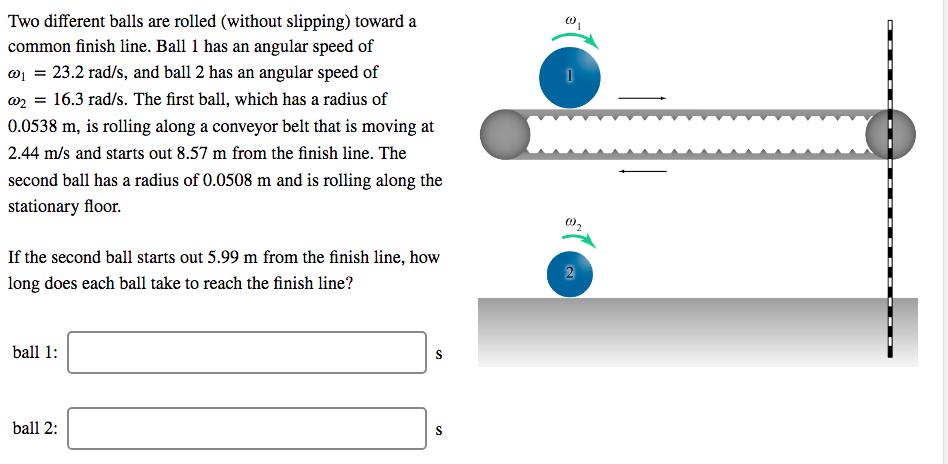Two different balls are rolled (without slipping) toward a common finish line. Ball 1 has an angular speed of 01 = 23.2 rad/s, and ball 2 has an angular speed of w2 = 16.3 rad/s. The first ball, which has a radius of 20000 0.0538 m, is rolling along a conveyor belt that is moving at 2.44 m/s and starts out 8.57 m from the finish line. The second ball has a radius of 0.0508 m and is rolling along the stationary floor. If the second ball starts out 5.99 m from the finish line, how long does each ball take to reach the finish line? ball 1: ball 2: What angular speed would the losing ball have needed to cross the finish line at the same time as the winning ball? angular speed: rad/s
Two different balls are rolled (without slipping) toward a common finish line. Ball 1 has an angular speed of 01 = 23.2 rad/s, and ball 2 has an angular speed of w2 = 16.3 rad/s. The first ball, which has a radius of 20000 0.0538 m, is rolling along a conveyor belt that is moving at 2.44 m/s and starts out 8.57 m from the finish line. The second ball has a radius of 0.0508 m and is rolling along the stationary floor. If the second ball starts out 5.99 m from the finish line, how long does each ball take to reach the finish line? ball 1: ball 2: What angular speed would the losing ball have needed to cross the finish line at the same time as the winning ball? angular speed: rad/s
Principles of Physics: A Calculus-Based Text
5th Edition
ISBN:9781133104261
Author:Raymond A. Serway, John W. Jewett
Publisher:Raymond A. Serway, John W. Jewett
Chapter10: Rotational Motion
Section: Chapter Questions
Problem 11P: A disk 8.00 cm in radius rotates at a constant rate of 1200 rev/min about its central axis....
Related questions
Question
please answer this is one question

Transcribed Image Text:Two different balls are rolled (without slipping) toward a
common finish line. Ball 1 has an angular speed of
01 = 23.2 rad/s, and ball 2 has an angular speed of
w2 = 16.3 rad/s. The first ball, which has a radius of
20000
0.0538 m, is rolling along a conveyor belt that is moving at
2.44 m/s and starts out 8.57 m from the finish line. The
second ball has a radius of 0.0508 m and is rolling along the
stationary floor.
If the second ball starts out 5.99 m from the finish line, how
long does each ball take to reach the finish line?
ball 1:
ball 2:

Transcribed Image Text:What angular speed would the losing ball have needed to
cross the finish line at the same time as the winning ball?
angular speed:
rad/s
Expert Solution
This question has been solved!
Explore an expertly crafted, step-by-step solution for a thorough understanding of key concepts.
This is a popular solution!
Trending now
This is a popular solution!
Step by step
Solved in 4 steps

Knowledge Booster
Learn more about
Need a deep-dive on the concept behind this application? Look no further. Learn more about this topic, physics and related others by exploring similar questions and additional content below.Recommended textbooks for you

Principles of Physics: A Calculus-Based Text
Physics
ISBN:
9781133104261
Author:
Raymond A. Serway, John W. Jewett
Publisher:
Cengage Learning

Glencoe Physics: Principles and Problems, Student…
Physics
ISBN:
9780078807213
Author:
Paul W. Zitzewitz
Publisher:
Glencoe/McGraw-Hill

Physics for Scientists and Engineers: Foundations…
Physics
ISBN:
9781133939146
Author:
Katz, Debora M.
Publisher:
Cengage Learning

Principles of Physics: A Calculus-Based Text
Physics
ISBN:
9781133104261
Author:
Raymond A. Serway, John W. Jewett
Publisher:
Cengage Learning

Glencoe Physics: Principles and Problems, Student…
Physics
ISBN:
9780078807213
Author:
Paul W. Zitzewitz
Publisher:
Glencoe/McGraw-Hill

Physics for Scientists and Engineers: Foundations…
Physics
ISBN:
9781133939146
Author:
Katz, Debora M.
Publisher:
Cengage Learning

University Physics Volume 1
Physics
ISBN:
9781938168277
Author:
William Moebs, Samuel J. Ling, Jeff Sanny
Publisher:
OpenStax - Rice University

College Physics
Physics
ISBN:
9781285737027
Author:
Raymond A. Serway, Chris Vuille
Publisher:
Cengage Learning

College Physics
Physics
ISBN:
9781305952300
Author:
Raymond A. Serway, Chris Vuille
Publisher:
Cengage Learning